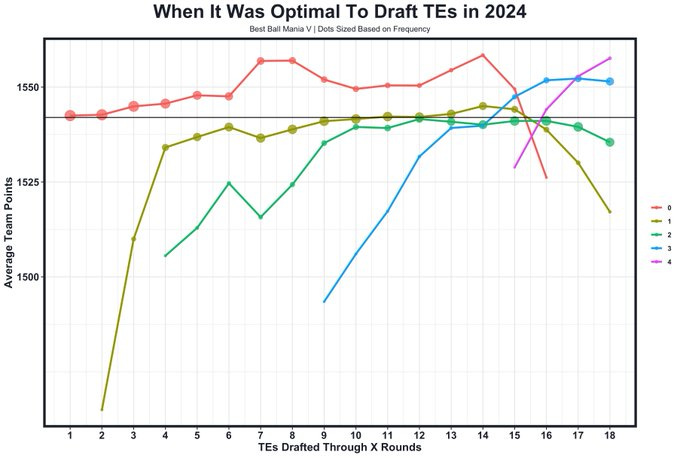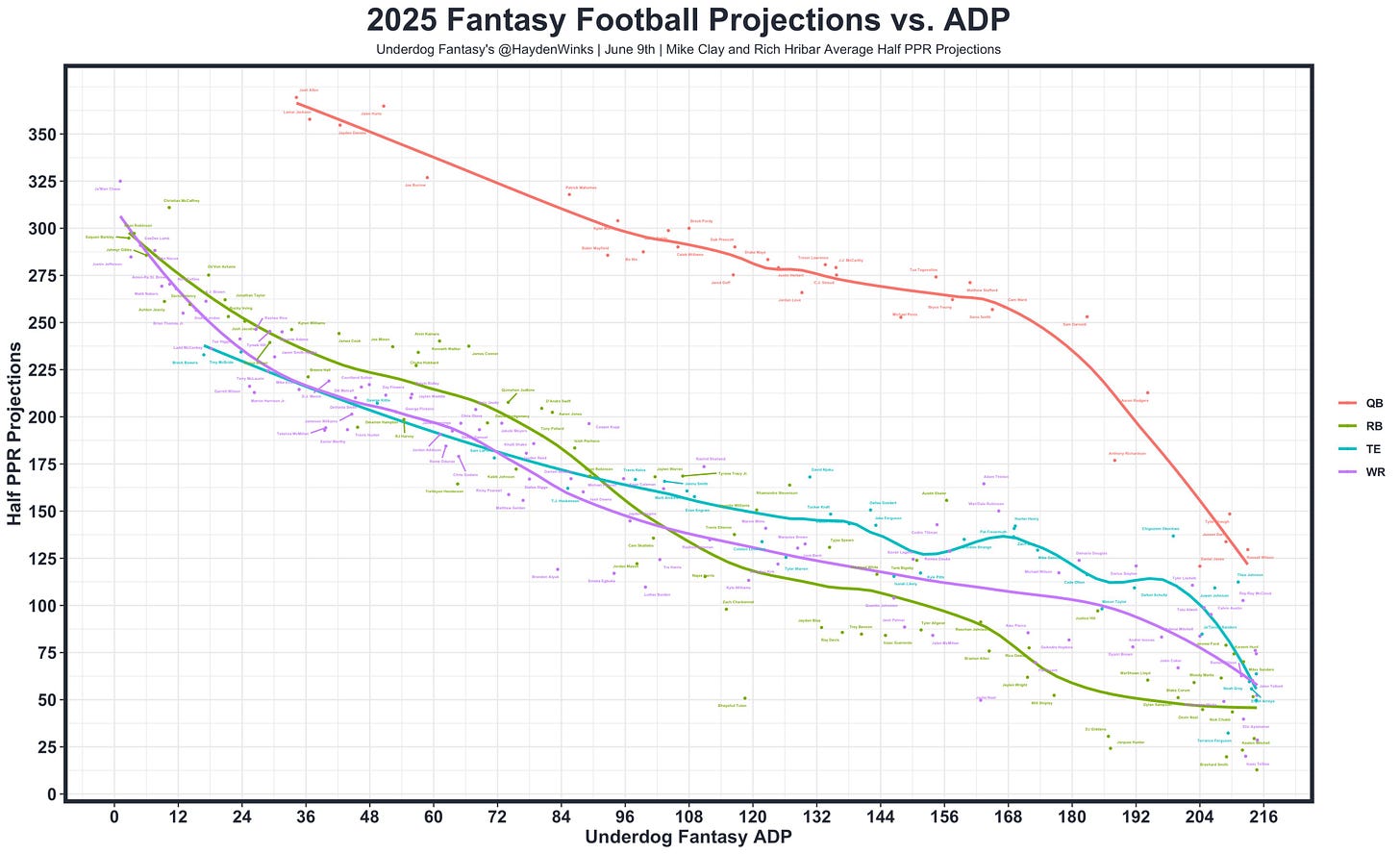In 2023, I published Tight End Strategy in Best Ball Mania IV, and in 2024, I published Tight End Spike Weeks are a Playoff Skeleton Key. I’ve come close to a full tight end strategy piece for 2025 multiple times, but I’ve been reticent to write it, as I view most people’s opinions on the elite vs punt debate as largely static at this point. Both strategies have their advocates, and each offers clear advantages and disadvantages.
However, the landscape is meaningfully different this year, and tight end spike weeks are a critical key to success in the best ball playoffs, so a full strategy piece felt warranted. So, without further ado, let’s dive into what makes 2025 different.
The New Tight End Landscape
This chart illustrates the change in the tight end landscape this year compared to the past few years of Best Ball Mania.
As you’ll notice, the yellow dots (which represent TE ADP this year) are far below the other dots on the line starting at TE3 and remaining there until ~TE10. Even from TE11 to TE21, the tight end ADPs are still largely below the dots from the previous years. Perhaps most telling, is that from the first tight end drafted, Brock Bowers, until TE21 Pat Freiermuth, exactly one TE is priced at the highest level of his positional ADP (TE11).
Put simply, the market is screaming that tight ends do not matter.
Why is this?
Essentially, the market is accounting for the fact that elite tight ends have largely failed to deliver in advance rate. Last year, many industry folks, including me, were bullish on a slew of elite tight ends that mostly failed in the regular season, as we can see from Hayden Winks’ chart below.
And last year’s result matches the data from previous seasons, where late tight end builds edged out elite tight end teams in advance rate.
Put simply, if you wanted the best advance rate from 2021-2024, you were better off using a punt tight end strategy than a elite tight end strategy.1
However, as we see from the chart, this has flipped in the playoff weeks, with the elite tight ends offering slightly better semi-final and final advance rates, including in 2024. So, conversely, if you wanted the best chance at advancing in the playoff weeks from 2021-2024, you were better off using an elite tight end strategy.
What does this mean for 2025?
As usual, I think there are compelling reasons to use either an elite or punt strategy.
For the punt strategy, it’s a simple bet. Projections go brr.
As we see from the chart above, tight ends start projecting better than running backs and wide receivers in round 8 and maintain that lead until the end of the draft. This isn’t surprising, as no backup tight ends are drafted, while by round 8, all clear RB1 and WR 1+2s are gone. By leaning into this edge and taking three tight ends in round 8 or later, you’re likely to project better in week one than the teams that selected an elite tight end. Assuming the projections largely hold throughout the season and your team stays healthy, your punt tight end team probably has a slight edge in advance rate, like what the data has shown from the past several years.2
Easy game.
For the elite tight ends, the market has decided there’s only three of them in 2025, in Bowers, McBride, and Kittle, and it’s priced them relatively cheaply to the past TE1-3.3 While Bowers started near the 1/2 turn, his ADP has fallen to pick 18. Similarly, McBride has slightly fallen to pick 25, and if Bowers continues to fall, McBride almost certainly has to move down as well. Kittle started as the cheapest TE3 we’ve had and has stayed at that spot thus far. While Bowers and McBride may have opened as slightly more expensive than the last few TE1/TE2s, that’s largely gone now.
Assuming the market is correct that there is only three elite tight ends, the chance of a tight end spike in any given week is probably less than in previous years, including in the playoffs. That’s great news for the punt tight end strategy, as it invests less draft capital into the position, and is less likely to be buried by a spike week from one of the elite tight ends in the playoffs.
However, while the overall chance of a tight end spike is less, the impact of a playoff spike is probably greater, as the the spiking tight end probably separates further from the field than in previous years.4
Furthermore, the probability is high that one of Bowers, McBride, or Kittle is the tight end to provide that spike week. That combination of impact and predictability is what has made the elite tight ends so valuable, even going back to the early days of best ball, and as we see below.
That’s quite bullish for the elite tight ends’ prospects in the playoff weeks, reinforcing the “playoff spike week” case from the last few seasons. But that’s not the only thing in the favor of this year’s crop of elite tight ends.
While Mark Andrews and George Kittle have been key playoff pieces the last few seasons, each was essentially a spike week bet, with high weekly volatility. Neither offered a weekly projection similar to the wide receivers going near them in ADP.
In 2025, each of Bowers and McBride does.
As for Kittle, the market is pricing him like a spike week option given his 4/5 turn ADP. And I get it. Kittle has primarily been a spike week option the last few seasons. But Kittle was more than that last year, consolidating volume on an aggressive Brock Purdy offense that was without Brandon Aiyuk, Christian McCaffrey, and Deebo Samuel for much of the year. Kittle had 11 games of 6+ targets and 11 games with more than 50 yards. He had 7 games with a touchdown and 4 100-yard games,
finishing as a TE1 in all but two of his games.
Put simply, Kittle was not just a spike week guy, and largely matched Bowers and McBride step for step in 2024. While he probably has more competition for targets in 2025, there’s uncertainty with each of Jajuan Jennings (one good season), Ricky Pearsall (1.45 YPPR, minimal production), Aiyuk (probably misses 4+ games, slow ramp-up), and even McCaffrey (age, return from injuries).
Ultimately, while Kittle is probably not the favorite to be his teams #1 receiving option in the same way that Bowers and McBride are, he straight up out-projects wide receivers AND running backs going near him. Because of this, Kittle should probably go near the 3/4 turn simply from a projection standpoint, without factoring in the elite spike week upside that has made him arguably the most valuable player in Best Ball Mania history.5
Put simply, the elite tight ends are probably both better projection bets and playoff spike week bets than the last few seasons, even amidst a landscape that has de-emphasized the position.
So, after making a case for both the punt and elite tight end strategy, how do we play it?
How I’m Playing Tight End in 2025
My strategy is contest dependent this year, taking a strong stance for the elite tight ends in the tournaments with the most intense playoff weeks, including Best Ball Mania and The Puppy, as each has 1/10 or more difficult pod advance rates in week 15 and 16, and a large final in week 17. I’m also drafting more of The Sprint, which has a three week cumulative playoff format from weeks 15-17, which I view as the best tournament for the elite tight ends.6
In these tournaments, I expect to draft 20%+ of Bowers and Kittle, with McBride likely coming in around 15%, though this would rise if Kittle moved to the mid-4th or higher.
Conversely, I prefer a punt tight end strategy for contests like the Marathon (cumulative scoring, no playoff weeks), The Hound Dog, and The Pug, and The Greyhound, as we’re less likely to need a huge tight end score in weeks 15 or 16 to advance, and can bet more exclusively on the elite tight ends failing in week 17.
For punt tight end teams (3 after round 8), I love targeting the tight ends tied to elite/very good quarterbacks, such as Mark Andrews, Dallas Goedert, Jake Ferguson, Isiah Likely, Tucker Kraft, Dalton Kincaid, and somewhat grudgingly, Travis Kelce. While none of these guys is likely an elite tight end at this point of their careers, they offer both a projection edge and spike week upside given the quarterbacks they play with and/or offenses they play on. On teams where you’ve drafted an elite quarterback, stacking him with one of these tight ends enables you to forego an early round tight end to stay ahead at running back and wide receiver, while maintaining spike week upside at tight end in the playoffs.7
After this tier, much of the spike week upside is gone, with Mike Gesicki and Zach Ertz tied to elite QBs but with some serious warts in their game from a ceiling standpoint.8 While the projection/advance rate edge likely remains through round 18, it’s difficult to find many players capable of spike weeks that will separate in the playoffs. Because of that, I prefer getting at least one of the tight ends from rounds 8-12, and ideally two, letting stacking/correlation usually decide which one I take in any given draft.
As far as Sam Laporta and T.J. Hockenson, I’m having a tough time with each, as I’ve written. Each has been a consistently good player thus far in their careers, and they are the cheapest TE4 and TE5 in the last four years. However, neither is likely to be the #1 option on their teams (or arguably even #2), making them fundamentally different bets than the elites, and probably closer to the tight ends in round 8 and beyond. While I believe each is a better spike week bet than the round 8+ tight ends, the opportunity cost is much higher and running back and receiver, and I’ll probably continue to de-emphasize each. That said, when I do take them, I want to treat each like more of an elite tight end, as it will slightly reduce the opportunity cost by enabling me to tack on one extra running back or receiver. And if a Lions/Vikings weapon missed time, it’s likely that they would perform closer to an elite tight end level.
In summary, it’s probably a fine year to use either the elite tight end or punt tight end strategy, and I recommend letting contest selection be the primary decider.
For me, that means I’ll draft more of The Sprint so I can take the elite tight end teams that I love. For those that prefer the punt tight end strategy, I’d recommend drafting more in the Marathon and the tournaments with less intense playoff formats.
As always, thanks for reading and happy drafting!
My definition of elite tight end is 2 tight ends total, one in round 6 or earlier.
My definition of punt tight end is 3 tight ends total, all three in round 7 or later.
There are multiple ways to adjust those definitions and get slightly different results, but that’s what has best matched the historic player pool and draft capital invested in my opinion.
Though, I will note, as soon as chaos strikes, and some RB/WRs step into larger roles, then they will dramatically increase their projections, while the TE projections will remain largely static. While I can appreciate week one projection analysis and its value, using it as your primary guide in tournaments that primarily rely on week 15-17 production is as foolhardy as it is misguided.
You could arguably include Sam Laporta here, but his ADP has fallen from 65 to 72 since the open of BBM, suggesting the market does not view him as an elite tight end.
Again, the weakness of tight end is often a feature, not a bug, of the elite tight end strategy.
And especially these three tight ends, given their weekly projection edge compared to past elites
I’ll also note that if everything broke perfectly, one of the teams structured this way is the best bet to be the highest-scoring regular season team. Something like: Hurts/Dak + Goedert/Ferg + one of the best RB/WR scores in the field.
Gesicki can’t block well enough to stay on the field for playaction, which reduces his red zone/end zone opportunties. Ertz simply lacks explosiveness at this stage of his career.











Great article, Madison.
Good stuff. How does ur TE strategy shift in ffpc managed leagues?